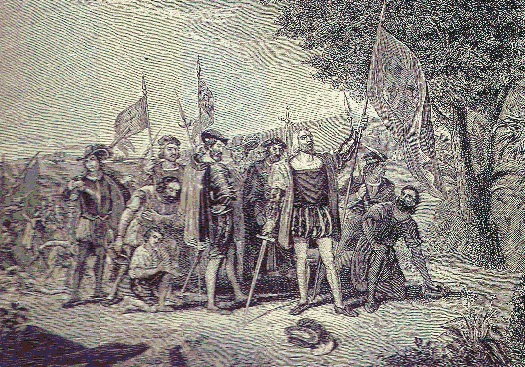Story of the Thirteen Colonies - Helene Guerber |
"Land! Land!"
In 1492, therefore, more than eighteen years after he began asking for help to carry out his daring plan, Columbus sailed out of the port of Palos with three little vessels—the Santa Maria, the Pinta, and the Nina. Columbus himself commanded the first, the Pinzon brothers were captains of the other ships, and the crews, all told, consisted of about one hundred men.
The vessels were small and uncomfortable, without real decks, cabins, or holds; but Columbus started out boldly to brave unknown dangers and venture into strange seas. His course was first southward, because he intended to get fresh water at the Canary Islands before sailing due west in search of Asia.
Although still in well-known waters, the seamen already seemed doubtful and afraid, and the third day after they sailed, the Pinta signaled that there was something wrong, Columbus soon learned that her rudder was out of order; and although Pinzon tried to mend it, his vessel could not sail fast.
![[Illustration] from Story of the Thirteen Colonies by Helene Guerber [Illustration] from Story of the Thirteen Colonies by Helene Guerber](https://heritage-history.com/books/guerber/thirteen/zpage045.gif) THE SANTA MARIA |
When Columbus came to the Canary Islands the rudder was properly repaired, and while waiting for that to be done, he heard from the inhabitants that after strong westerly winds they had often found on the beach strangely carved bits of wood. Once two bodies were washed ashore, and the islanders said they were those of men unlike any race ever seen in Europe or the parts of Asia and Africa with which they were familiar.
Setting out from the Canaries, Columbus quieted the fears of his crew, when they came within sight of Mount Tenerife, by explaining to them that it was only a volcano, like Mount Etna. Then he steered directly westward.
The men's hearts sank as they lost sight of land, and all began to think over the terrible stories they had heard. People who are always looking out for something to get scared at are easily frightened; so when the three ships sailed into the warm waters of the middle Atlantic, where seaweed grows in such quantity as to make the sea look green, the sailors were terrified.
But Columbus was no faint-heart, and he steered right on, making the ships cut their way through the floating masses of seaweed in the Sargasso Sea, as that part of the Atlantic is called. Perceiving that his men grew more frightened as the distance increased between them and their homes, Columbus did not tell them how many miles they had really gone, but carefully kept the account for his own use. To cheer his men, he promised a great reward to the first who caught sight of land.
Instead of looking for mermaids, monsters, and boiling seas, the sailors now began to watch for land, and several times they mistook clouds for distant mountain peaks. Day after day passed on, until the men, horror-struck at the endless stretch of sea and sky, again and again begged Columbus to turn around; but he always refused.
Then they grew so angry that they plotted to throw him overboard and take command of the vessels themselves. They were on the point of doing this, when they saw a shrub covered with fresh berries floating over the waters. A little farther on they found a carved stick and a small board, and soon after beheld birds flying southward. By these signs they felt sure land must be near, and eagerly resumed their watch for it.
To please one of the Pinzon brothers, Columbus unwillingly consented to change his course and follow the birds; but if he had gone straight on he would have landed in what is now called Florida.
Standing on top of the poor little cabin of his vessel, on the evening of October i r, Columbus peered out into the darkness, wondering whether he would see land before him when the sun rose. Suddenly he fancied he saw a light. He called two men, and as they saw it too, he felt sure they were near land at last.
A few hours later, at early dawn on Friday morning, October 12, 1492, the Pinta, which was ahead, gave the joyful signal that land was in sight. When the sun rose, all on board beheld one of the Bahamas, which Columbus mistook for an island off the coast of Asia.
 LANDING OF COLUMBUS. |
Although uncultivated, the island was inhabited, and the Spaniards soon saw naked savages run out of their low huts, to stare in wonder at the ships. The poor creatures, who had never seen sailing vessels before, fancied that the boats had come straight down from the sky.
Dressed in scarlet, wearing beautiful armor, and carrying a flag which bore the crowns and initials of Ferdinand and Isabella, Columbus went ashore in a small boat. As he set foot upon land, he fell on his knees, and after thanking God for bringing him there in safety, he took possession of the island in the name of the king and queen, and called it San Salvador.
His men, who had been disobedient, hateful, and ready to kill him such a short time before, now crowded around him, kissing his hands and feet, and begging his pardon for their past ill conduct. The natives, who had fled into the woods at the approach of the strangers, watched all these proceedings from behind the trees. After a short time they timidly carne forward, and, encouraged by the Spaniards' kind glances, wonderingly touched the white men's hands and beards, and evidently admired their gay apparel.
Columbus was so sure he was near India that he called the savages Indians, a name which has ever since been used for the red men in America. Then he gave them colored caps, glass beads, and little bells, trinkets which the Indians fancied were priceless heavenly treasures!